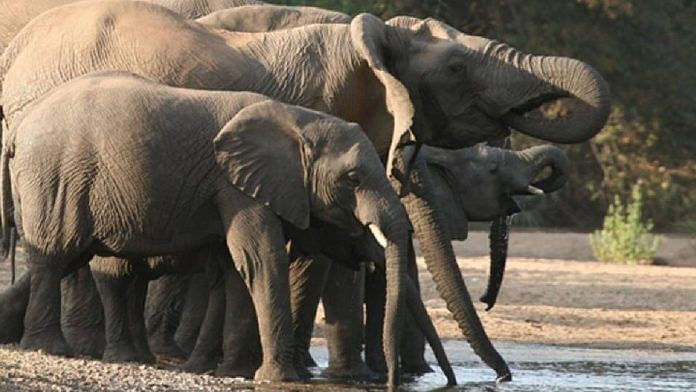New Delhi: Thousands of wild animals are being relocated in Zimbabwe as a part of a massive rescue mission from the drought-hit areas in the country, with climate change posing a threat to several species in the country.
According to a report, about 400 elephants, 2,000 impalas, 70 giraffes, 50 buffaloes, 50 wildebeest, 50 zebras, 50 elands, 10 lions, and a pack of 10 wild dogs are among the animals being moved from Zimbabwe’s Save Valley Conservancy to three conservancies in the north — Sapi, Matusadonha, and Chizarira.
The ‘Project Rewild Zambezi’ — as the operation is called — is moving the animals to an area in the Zambezi River valley to rebuild the wildlife populations there.
It’s the first time in 60 years that Zimbabwe has embarked on such a mass internal movement of wildlife. Between 1958 and 1964, in erstwhile Rhodesia, more than 5,000 animals were moved in what was called ‘Operation Noah’.
That operation rescued wildlife from the rising water caused by the construction of a massive hydroelectric dam on the Zambezi River that created one of the world’s largest man-made lakes, Lake Kariba.
The effects of climate change on wildlife are not isolated to Zimbabwe. Across Africa, national parks that are home to myriad wildlife species such as lions, elephants, and buffaloes are increasingly threatened by below-average rainfall and new infrastructure projects.
Authorities and experts say the drought has seriously threatened species like rhinos, giraffes, and antelope as it reduces the amount of food available. Read more
Also Read: Dust found on asteroid Ryugu older than our solar system: Study
Researchers design biodegradable batteries from crab shells
Scientists have created a zinc battery with a biodegradable electrolyte from crab shells — an advance that may help make renewable energy and electric vehicles more sustainable.
While batteries are an essential part of carbon-free energy sources, the vast range of batteries being produced and consumed also raises environmental concerns. Polypropylene and polycarbonate are widely used in lithium-ion batteries, which take hundreds or thousands of years to degrade.
Batteries use an electrolyte to shuttle ions back and forth between positively and negatively charged terminals. An electrolyte can be a liquid, paste, or gel, and many batteries use flammable or corrosive chemicals for this function.
This new battery, which could store power from large-scale wind and solar sources, uses a gel electrolyte made from a biological material called chitosan.
Chitosan is a derivative product of chitin, which can also be extracted from the cell walls of fungi, the exoskeletons of crustaceans, and squid pens.
However, the most abundant source of chitosan is the exoskeletons of crustaceans, including crabs, shrimps, and lobsters, which can be easily obtained from seafood waste.
A biodegradable electrolyte means that about two-thirds of the battery could be broken down by microbes — this chitosan electrolyte broke down completely within five months. This leaves behind the metal component, in this case, zinc, rather than lead or lithium, which could be recycled. Read more
Mice grow bigger on the rainier sides of mountains
Researchers studying mice from the Andes Mountains in Patagonia have found that mice from the side of the mountains that get more rain are bigger than the ones in the rain shadow.
The team says that this may be a new law of nature. According to the team from Chicago’s Field Museum, the mice on the western slopes of the mountain were bigger because that side of the mountain range gets more rain, which means there’s more plentiful food for the mice to eat.
When the team first found the difference in the sizes, they compared the DNA and skull sizes. However, existing biological laws did not explain the size differences.
In a study published in the Journal of Biogeography, the scientists put forth a new hypothesis suggesting that the rain-shadow effect can cause changes in the size and shape of mammals.
The rain-shadow effect is a product of the way that water vapor travels over mountain ranges. The air over the ocean picks up water vapour, and as the ocean naturally warms, this water vapour rises.
Prevailing winds, like the jet stream that goes from west to east, push this air from the ocean to the land, and as the air makes its way over mountain ranges, it gets colder as it goes up in elevation. The water vapour in the cold air condenses and falls as rain. If the mountain is really high, the air will run out of moisture by the time it gets to the far side of the peak. Read more
Scientists discover Africa’s oldest dinosaur species
Scientists have discovered the oldest dinosaur species that ever lived on the African continent.
The dinosaur, a sauropodomorph, lived in present-day Zimbabwe some 230 million years ago. It is also among the oldest species found on Earth. According to the researchers from Yale University, the finding answers some fundamental questions of dinosaur evolution, such as why dinosaurs lived only in some parts of the ancient supercontinent, Pangaea.
The nearly complete skeleton was unearthed after five years of excavations at the Pebbly Arkose Formation in northern Zimbabwe since 2017.
The species has been named Mbiresaurus raathi after Mbire — the Shona dynasty that once ruled the region, and Michael Raath, who helped discover the first fossils in the area.
Sauropodomorph are a relative of the long-necked sauropods like Brachiosaurus and Apatosaurus. Read more
(Edited by Uttara Ramaswamy)
Also Read: Diversity among reptiles a result of global warming 250 years ago, finds study



